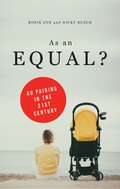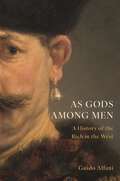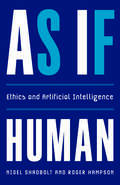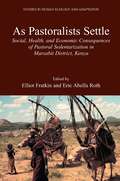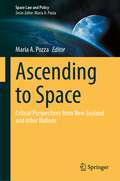- Table View
- List View
As an Equal?: Au Pairing in the 21st Century
by Rosie Cox Nicky BuschAu pairs are relied upon by tens of thousands of UK families to do everything from childcare and housework to elder care, pet feeding and waiting at dinner parties. Traditionally thought of as privileged and well-educated young women having fun on a 'gap year' abroad, au pairs have been excluded from many of the recent discussions on migrant domestic labour. However, since 2008 au pairing has been effectively unregulated in the UK and the result is that au pairs now constitute one of the poorest paid and least protected groups of workers.Through an examination of lived experiences, As an Equal? draws on detailed research to examine au pairs and the families who host them in contemporary Britain, revealing au pairing to have become increasingly indistinguishable from other forms of domestic labour. Crucially, hosting an au pair is shown to form part of families' attempts to provide good (enough) childcare in the context of extended working hours and poor public childcare provision. This increased reliance of families on an exploited workforce is shown to form part of the wider political climate of economic austerity, and raises profound questions about the position of women within the neoliberal economy.
As Far as the Eye can See: A History of Seeing
by S. Denham WadeEyes were one of the very first body parts to evolve more than 500 million years ago, and their structure has remained virtually unchanged through most of evolutionary history. But eyes alone were never enough for Homo sapiens. From the mastery of fire a million years ago to the smartphone today, humans have repeatedly invented new ways to see their surroundings, each other and themselves. Artificial light, art, mirrors, writing, lenses, printing, photography, film, television, smartphones – these tools didn’t just add to our visual repertoire, they shaped cultures around the world and made us who we are. Drawing on sources from anthropology to zoology, neuroscience to Netflix, As Far As the Eye Can See traces the history of seeing from the first evolutionary stirrings of sight and discovers that each time we changed how or what we see, we changed ourselves and the world around us. Along the way, it finds, sight slowly eclipsed our other senses. Are we now at ‘peak seeing’, the author asks. Can our eyes keep up with technology? Have we gone as far as the eye can see?
As Gods Among Men: A History of the Rich in the West
by Guido AlfaniHow the rich and the super-rich throughout Western history accumulated their wealth, behaved (or misbehaved) and helped (or didn&’t help) their communities in times of crisis The rich have always fascinated, sometimes in problematic ways. Medieval thinkers feared that the super-rich would act 'as gods among men&’; much more recently Thomas Piketty made wealth central to discussions of inequality. In this book, Guido Alfani offers a history of the rich and super-rich in the West, examining who they were, how they accumulated their wealth and what role they played in society. Covering the last thousand years, with frequent incursions into antiquity, and integrating recent research on economic inequality, Alfani finds—despite the different paths to wealth in different eras—fundamental continuities in the behaviour of the rich and public attitudes towards wealth across Western history. His account offers a novel perspective on current debates about wealth and income disparity.Alfani argues that the position of the rich and super-rich in Western society has always been intrinsically fragile; their very presence has inspired social unease. In the Middle Ages, an excessive accumulation of wealth was considered sinful; the rich were expected not to appear to be wealthy. Eventually, the rich were deemed useful when they used their wealth to help their communities in times of crisis. Yet in the twenty-first century, Alfani points out, the rich and the super-rich—their wealth largely preserved through the Great Recession and COVID-19—have been exceptionally reluctant to contribute to the common good in times of crisis, rejecting even such stopgap measures as temporary tax increases. History suggests that this is a troubling development—for the rich, and for everyone else.
As Gods Among Men: A History of the Rich in the West
by Guido AlfaniHow the rich and the super-rich throughout Western history accumulated their wealth, behaved (or misbehaved) and helped (or didn&’t help) their communities in times of crisis The rich have always fascinated, sometimes in problematic ways. Medieval thinkers feared that the super-rich would act 'as gods among men&’; much more recently Thomas Piketty made wealth central to discussions of inequality. In this book, Guido Alfani offers a history of the rich and super-rich in the West, examining who they were, how they accumulated their wealth and what role they played in society. Covering the last thousand years, with frequent incursions into antiquity, and integrating recent research on economic inequality, Alfani finds—despite the different paths to wealth in different eras—fundamental continuities in the behaviour of the rich and public attitudes towards wealth across Western history. His account offers a novel perspective on current debates about wealth and income disparity.Alfani argues that the position of the rich and super-rich in Western society has always been intrinsically fragile; their very presence has inspired social unease. In the Middle Ages, an excessive accumulation of wealth was considered sinful; the rich were expected not to appear to be wealthy. Eventually, the rich were deemed useful when they used their wealth to help their communities in times of crisis. Yet in the twenty-first century, Alfani points out, the rich and the super-rich—their wealth largely preserved through the Great Recession and COVID-19—have been exceptionally reluctant to contribute to the common good in times of crisis, rejecting even such stopgap measures as temporary tax increases. History suggests that this is a troubling development—for the rich, and for everyone else.
As Good as a Marriage: The Anne Lister Diaries 1836–38
by Jill LiddingtonThe BBC and HBO series Gentleman Jack brought Anne Lister to international attention, awakening tremendous interest in her diaries, which run to nearly five million words and are partly written in her secret code. They record in intimate detail Anne’s intellectual energy and her challenges to so many of society’s expectations of women at the time.In As Good as a Marriage, the sequel to Female Fortune, Jill Liddington’s edited transcriptions of the diaries show us Anne from 1836–38. She guides the reader through life at Shibden Hall after Anne’s unconventional ‘marriage’ to wealthy local heiress Ann Walker. The book explores the daily lives of these two women, from convivial evenings together to her ruthless pursuit of her own business and landowning ambitions.Yet the diaries’ coded passages also record tensions and quarrels, with Ann Walker often in tears. Was their relationship really as fragile as Anne’s coded writing suggests? This question is at the heart of As Good as a Marriage.
As Good as a Marriage: The Anne Lister Diaries 1836–38
by Jill LiddingtonThe BBC and HBO series Gentleman Jack brought Anne Lister to international attention, awakening tremendous interest in her diaries, which run to nearly five million words and are partly written in her secret code. They record in intimate detail Anne’s intellectual energy and her challenges to so many of society’s expectations of women at the time.In As Good as a Marriage, the sequel to Female Fortune, Jill Liddington’s edited transcriptions of the diaries show us Anne from 1836–38. She guides the reader through life at Shibden Hall after Anne’s unconventional ‘marriage’ to wealthy local heiress Ann Walker. The book explores the daily lives of these two women, from convivial evenings together to her ruthless pursuit of her own business and landowning ambitions.Yet the diaries’ coded passages also record tensions and quarrels, with Ann Walker often in tears. Was their relationship really as fragile as Anne’s coded writing suggests? This question is at the heart of As Good as a Marriage.
As If: Idealization and Ideals
by Kwame Anthony AppiahIdealization is a basic feature of human thought. We proceed “as if” our representations were true, while knowing they are not. Kwame Anthony Appiah defends the centrality of the imagination in science, morality, and everyday life and shows that our best chance for accessing reality is to open our minds to a plurality of idealized depictions.
As If: Idealization and Ideals
by Kwame Anthony AppiahIdealization is a basic feature of human thought. We proceed “as if” our representations were true, while knowing they are not. Kwame Anthony Appiah defends the centrality of the imagination in science, morality, and everyday life and shows that our best chance for accessing reality is to open our minds to a plurality of idealized depictions.
As If Already Free: Anthropology and Activism After David Graeber (Anthropology, Culture and Society)
by Holly High and Joshua O. Reno“Contains precious insights into what made David Graeber the most innovative social thinker of our time, and why the legacy of his ideas will inspire projects of emancipation for generations” – David Wengrow, Professor, University College London, co-author with David Graeber of The Dawn of Everything“A must-read for anyone who believes in the power of academia as activism” – Sophie Chao, University of SydneyDavid Graeber (1961–2020) was an American anthropologist and anarchist activist, who left us with new ways to understand humankind. This collection of new writing brings together his insights into one book, showing how deeply his work continues to influence us today.Graeber’s writing resonates with scholars and activists looking to shake things up. The impact of his work is broad in scope, from birth to banking, and he picks open social hierarchy and political power to expose what really makes human society tick.In today’s neoliberal world, we can turn to his legacy to provide a way for us to understand what went wrong, and how to fix it. This collection of writings is both an introduction to his life and works, a guide to his key ideas, and an inspiring example of how people are continuing to use his work today.Holly High is an Associate Professor at Deakin University, Australia. She has written two books, Fields of Desire and Projectland. Joshua O. Reno is a Professor at Binghamton University, US. A socio-cultural anthropologist, he is the author of Waste Away, Military Waste and co-author of Imagining the Heartland.
As If Human: Ethics and Artificial Intelligence
by Nigel Shadbolt Roger HampsonA new approach to the challenges surrounding artificial intelligence that argues for assessing AI actions as if they came from a human being Intelligent machines present us every day with urgent ethical challenges. Is the facial recognition software used by an agency fair? When algorithms determine questions of justice, finance, health, and defense, are the decisions proportionate, equitable, transparent, and accountable? How do we harness this extraordinary technology to empower rather than oppress? Despite increasingly sophisticated programming, artificial intelligences share none of our essential human characteristics—sentience, physical sensation, emotional responsiveness, versatile general intelligence. However, Nigel Shadbolt and Roger Hampson argue, if we assess AI decisions, products, and calls for action as if they came from a human being, we can avert a disastrous and amoral future. The authors go beyond the headlines about rampant robots to apply established moral principles in shaping our AI future. Their new framework constitutes a how-to for building a more ethical machine intelligence.
AS Media Studies: The Essential Introduction for WJEC
by Antony Bateman Sarah Casey Benyahia Claire Mortimer Peter WallThis full colour, highly illustrated textbook is designed to support students through their WJEC AS in Media Studies. Individual chapters cover the following key areas: Textual Analysis: Visual, Technical and Audio codes Textual Analysis: Narrative and Genre Codes Approaches to Representation Approaches to Audience Response Case Studies on Representation and Audience: Gender, Age, Ethnicity, Identity, Events and Issues Passing MS1: Media Representations and Receptions Production Work, Evaluation and report Specially designed to be user-friendly, AS Media Studies: The Essential Introduction for WJEC includes activities, key terms, case studies and sample exam questions. It introduces the course, tackles useful approaches to study, key content covered in the specification, and guides the student in approaching and planning the exam and production work through analysis, prompts and activities.
AS Media Studies: The Essential Introduction for WJEC
by Antony Bateman Sarah Casey Benyahia Claire Mortimer Peter WallThis full colour, highly illustrated textbook is designed to support students through their WJEC AS in Media Studies. Individual chapters cover the following key areas: Textual Analysis: Visual, Technical and Audio codes Textual Analysis: Narrative and Genre Codes Approaches to Representation Approaches to Audience Response Case Studies on Representation and Audience: Gender, Age, Ethnicity, Identity, Events and Issues Passing MS1: Media Representations and Receptions Production Work, Evaluation and report Specially designed to be user-friendly, AS Media Studies: The Essential Introduction for WJEC includes activities, key terms, case studies and sample exam questions. It introduces the course, tackles useful approaches to study, key content covered in the specification, and guides the student in approaching and planning the exam and production work through analysis, prompts and activities.
AS Media Studies: The Essential Introduction for AQA (Essentials)
by Peter Wall Philip RaynerAS Media Studies: The Essential Introduction for AQA is fully revised for the current specification with full colour throughout, over 100 images, new case studies and examples. The authors introduce students step-by-step to the skills of reading media texts, and address key concepts such as genre, representation, media institutions and media audiences as well as taking students through the tasks expected of them to pass the AQA AS Media Studies exam. The book is supplemented with a companion website at www.asmediastudies.co.uk featuring additional activities and resources, further new case studies such as music and sport, clear instructions on producing different media, quizzes and tests. Areas covered include: an introduction to studying the media the key concepts across print, broadcast and e-media media institutions audiences and the media case studies such as Heroes, Nuts, and The Daily Mail guided textual analysis of real media on the website and within the book research and how to do it preparing for exams a production guide and how to respond to a brief. AS Media Studies: The Essential Introduction for AQA clearly guides students through the course and gives them the tips they need to become proficient media producers as well as media analysts.
AS Media Studies: The Essential Introduction for AQA (Essentials)
by Peter Wall Philip RaynerAS Media Studies: The Essential Introduction for AQA is fully revised for the current specification with full colour throughout, over 100 images, new case studies and examples. The authors introduce students step-by-step to the skills of reading media texts, and address key concepts such as genre, representation, media institutions and media audiences as well as taking students through the tasks expected of them to pass the AQA AS Media Studies exam. The book is supplemented with a companion website at www.asmediastudies.co.uk featuring additional activities and resources, further new case studies such as music and sport, clear instructions on producing different media, quizzes and tests. Areas covered include: an introduction to studying the media the key concepts across print, broadcast and e-media media institutions audiences and the media case studies such as Heroes, Nuts, and The Daily Mail guided textual analysis of real media on the website and within the book research and how to do it preparing for exams a production guide and how to respond to a brief. AS Media Studies: The Essential Introduction for AQA clearly guides students through the course and gives them the tips they need to become proficient media producers as well as media analysts.
As Nomadism Ends: The Israeli Bedouin Of The Negev
by Avinoam MeirAs pastoral nomads become settled, they face social, spatial, and ecological change in the shift from herding to farming, toward integration into the market economy. This book analyzes the socio-spatial changes that follow the end of nomadism, especially in the unique case of the Bedouin of the Negev. The culture of the Negev Bedouin stands in shar
As Nomadism Ends: The Israeli Bedouin Of The Negev
by Avinoam MeirAs pastoral nomads become settled, they face social, spatial, and ecological change in the shift from herding to farming, toward integration into the market economy. This book analyzes the socio-spatial changes that follow the end of nomadism, especially in the unique case of the Bedouin of the Negev. The culture of the Negev Bedouin stands in shar
As Pastoralists Settle: Social, Health, and Economic Consequences of the Pastoral Sedentarization in Marsabit District, Kenya (Studies in Human Ecology and Adaptation #1)
by Elliot Fratkin Eric Abella RothThroughout the world's arid regions, and particularly in northern and eastern Africa, formerly nomadic pastoralists are undergoing a transition to settled life. This reference shows that although pastoral settlement is often encouraged by international development agencies and national governments, the social, economic and health consequences of sedentism are not inevitably beneficial.
As Seen on TV: The Visual Culture Of Everyday Life In The 1950s
by Karal Ann MarlingFrom the painting-by-numbers fad to the public fascination with the First Lady's apparel to the television sensation of Elvis Presley to the sculptural refinement of the automobile, Marling explores what Americans saw and what they looked for in the 1950s with a gaze newly trained by TV.
As Seen on TV: The Visual Culture Of Everyday Life In The 1950s
by Karal Ann MarlingFrom the painting-by-numbers fad to the public fascination with the First Lady's apparel to the television sensation of Elvis Presley to the sculptural refinement of the automobile, Marling explores what Americans saw and what they looked for in the 1950s with a gaze newly trained by TV.
As the World Ages: Rethinking a Demographic Crisis
by Kavita Sivaramakrishnan SivaramakrishnanPeople are living longer, creating an unexpected boom in the elderly population. Longevity is increasing not only in wealthy countries but in developing nations as well. In response, many policy makers and scholars are preparing for a global crisis of aging. But for too long, Western experts have conceived of aging as a universal predicament—one that supposedly provokes the same welfare concerns in every context. In the twenty-first century, Kavita Sivaramakrishnan writes, we must embrace a new approach to the problem, one that prioritizes local agendas and values. As the World Ages is a history of how gerontologists, doctors, social scientists, and activists came to define the issue of global aging. Sivaramakrishnan shows that transnational organizations like the United Nations, private NGOs, and philanthropic foundations embraced programs that reflected prevailing Western ideas about development and modernization. The dominant paradigm often assumed that, because large-scale growth of an aging population happened first in the West, developing societies will experience the issues of aging in the same ways and on the same terms as their Western counterparts. But regional experts are beginning to question this one-size-fits-all model and have chosen instead to recast Western expertise in response to provincial conditions. Focusing on South Asia and Africa, Sivaramakrishnan shows how regional voices have argued for an approach that responds to local needs and concerns. The research presented in As the World Ages will help scholars, policy makers, and advocates appreciate the challenges of this recent shift in global demographics and find solutions sensitive to real life in diverse communities.
As the World Ages: Rethinking a Demographic Crisis
by Kavita Sivaramakrishnan SivaramakrishnanPeople are living longer, creating an unexpected boom in the elderly population. Longevity is increasing not only in wealthy countries but in developing nations as well. In response, many policy makers and scholars are preparing for a global crisis of aging. But for too long, Western experts have conceived of aging as a universal predicament—one that supposedly provokes the same welfare concerns in every context. In the twenty-first century, Kavita Sivaramakrishnan writes, we must embrace a new approach to the problem, one that prioritizes local agendas and values. As the World Ages is a history of how gerontologists, doctors, social scientists, and activists came to define the issue of global aging. Sivaramakrishnan shows that transnational organizations like the United Nations, private NGOs, and philanthropic foundations embraced programs that reflected prevailing Western ideas about development and modernization. The dominant paradigm often assumed that, because large-scale growth of an aging population happened first in the West, developing societies will experience the issues of aging in the same ways and on the same terms as their Western counterparts. But regional experts are beginning to question this one-size-fits-all model and have chosen instead to recast Western expertise in response to provincial conditions. Focusing on South Asia and Africa, Sivaramakrishnan shows how regional voices have argued for an approach that responds to local needs and concerns. The research presented in As the World Ages will help scholars, policy makers, and advocates appreciate the challenges of this recent shift in global demographics and find solutions sensitive to real life in diverse communities.
Asbestos Disaster: Lessons from Japan's Experience
by Kenichi Miyamoto, Kenji Morinaga and Hiroyuki MoriJapan’s asbestos disasters, encompassing both occupational disease and environmental pollution, have been caused principally by the asbestos textile, asbestos cement water pipe, and construction industries. This book is unique in its interdisciplinary approach to those disasters as it incorporates medical science, economics, political science, law, architecture, environmental engineering, sociology, and journalism. Written by authorities in their fields, the chapters reflect the integration of these disciplines in topics that include a historical review of asbestos issues in Japan, asbestos-related diseases, international aspects of the asbestos industry, public policy, divisions of responsibility, relief activities in emergencies, and countermeasures enacted by local governments. The lessons of asbestos problems and policies in Japan are particularly important for developing countries to prevent the proliferation of asbestos disasters. This volume serves as a textbook on asbestos issues for all countries, especially where there is widespread use of asbestos.
ASBO nation: The criminalisation of nuisance
by Peter SquiresAnti-social behaviour (ASB) has been a major preoccupation of New Labour's project of social and political renewal, with ASBOs a controversial addition to crime and disorder management powers. Thought by some to be a dangerous extension of the power to criminalise, by others as a vital dimension of local governance, there remains a concerning lack of evidence as to whether or not they compound social exclusion. This collection, from an impressive panel of contributors, brings together opinion, commentary, research evidence, professional guidance, debate and critique in order to understand the phenomenon of anti-social behaviour. It considers the earliest available evidence in order to evaluate the Government's ASB strategy, debates contrasting definitions of anti-social behaviour and examines policy and practice issues affected by it. Contributors ask what the recent history of ASB governance tells us about how the issue will develop to shape public and social policies in the years to come. Reflecting the perspectives of practitioners, victims and perpetrators, the book should become the standard text in the field.
ASBO nation: The criminalisation of nuisance
by Peter SquiresAnti-social behaviour (ASB) has been a major preoccupation of New Labour's project of social and political renewal, with ASBOs a controversial addition to crime and disorder management powers. Thought by some to be a dangerous extension of the power to criminalise, by others as a vital dimension of local governance, there remains a concerning lack of evidence as to whether or not they compound social exclusion. This collection, from an impressive panel of contributors, brings together opinion, commentary, research evidence, professional guidance, debate and critique in order to understand the phenomenon of anti-social behaviour. It considers the earliest available evidence in order to evaluate the Government's ASB strategy, debates contrasting definitions of anti-social behaviour and examines policy and practice issues affected by it. Contributors ask what the recent history of ASB governance tells us about how the issue will develop to shape public and social policies in the years to come. Reflecting the perspectives of practitioners, victims and perpetrators, the book should become the standard text in the field.
Ascending to Space: Critical Perspectives from New Zealand and other Nations (Space Law and Policy)
by Maria A. PozzaThis book explores multidisciplinary perspectives on critical issues in space from the viewpoints of New Zealand and other nations. It brings together the topics examined at the Otago Foreign Policy School 2022 by both domestic and international experts in the area of space, and includes the opening address on space policy delivered by the Minister of Foreign Affairs. This book takes a multidisciplinary approach to New Zealand’s growing space sector in conjunction with other nations’ perspectives on space. It encompasses space science, military and defence matters, space tourism and astronaut rescue, and international legal and policy frameworks, while taking into account future considerations. Readers such as academics, students, policy advisers, diplomats, government officials and others engaged in the field of space will find value in this book. It will appeal to think tanks and international institutions grappling with the complexities that are presented by the outer space domain.
